Heroes face adversity with aplomb and always seem to find a way to overcome whatever life tosses in front of them. They are fearless, capable of maintaining a buoyant, confident spirit, no matter what happens.
This is the depth of heroism that resides in Assistant Professor Jennifer Griswold, faculty member of the School of Ocean and Earth Science and Technology in the Department of Meteorology at the University of Hawaii at Manoa.
In the late 70s, Jennifer’s mother’s husband got a job as a computer scientist at IBM and her family relocated from New York City to Chicago. On the surface, it seemed all would be well, but his post-traumatic stress disorder after serving in the Korean War brought out another side of him that sent up a big red flag. Jennifer’s mom was brave enough to leave her husband, pack up Jennifer and her older brother, and head back to New York without giving it a second thought to protect her children.
An Inner Vow to Succeed
With no job to support the family, Jennifer’s family initially lived in their grandmother’s small apartment, but eventually moved to a small project, a 100-year-old building on Surf Avenue on Staten Island. It was slated for demolition, but a hurricane tore up the road and development plans for the area were permanently halted. It was the weather that allowed the family to continue living in the same rent-controlled home for $300 a month over the next 20 years.
“My mother struggled so much to support me and my brother,” Jennifer said, noting that her mother gave up her job as a statistician for an insurance company in Chicago, and took a job as a machinist at a local shop in New York for an annual salary of $18,000. Her mom later became a fish market salesperson at a local grocery and eventually a school aide at Jennifer’s high school, where she still works to this day.
Witnessing all of the stress left an indelible impression on Jennifer, and she resolved that when she grew up, she would not live that way nor be dependent on someone else.
For Jennifer, education was her ticket out of that life, her salvation, her path to freedom. She would break out and escape, but always cherish her mom’s example of sacrificial dedication.
Weather In Her Bones
Just as the weather played a fateful role in where Jennifer’s family lived, the weather would eventually be a driving force in Jennifer’s career choice. It started when she was young.
Jennifer recalls that she could predict when it would rain because she had sensitive ears and could feel the pressure change associated with a passing cold or warm front. Although her mother thought she was crazy, Jennifer would would wake up 10 minutes in advance of a wall of water coming down and got a bucket to collect the rain that poured in from their leaking roof – with consistent, amazing accuracy.
Jennifer said having this “super-power” allowed her to readily grasp concepts such as adiabatic temperature change that came in handy when she was a 12- or 13-year-old taking a boating license class in a sailing club. (An adiabatic temperature change is the change in temperature a parcel of air undergoes when it rises or sinks without a transfer of heat between the system.) Others in the class were “crusty, 60-year-old Popeyes” who could not understand these things as easily.
It’s no wonder that college was a natural fit for Jennifer. She was accepted into Cornell University but decided not to go there to avoid the cold temperatures. Instead, she chose Rutgers University in New Brunswick, New Jersey, a 30-minute commute from her home. Best of all, the school offered Jennifer scholarships for tuition, but she had to take out loans to pay for housing on campus, which she is still paying off.
The Sky’s the Limit
Jennifer sailed through school, earning two bachelor of science degrees in meteorology and environmental science from Rutgers. She then received a Ph.D. in earth and planetary science from the University of California – Santa Cruz. Doors began to swing wide open for her when she applied for post-doctoral research with the National Aeronautics and Space Administration’s Jet Propulsion Laboratory.
Jennifer said she cried when she found out she was selected to work at this prestigious NASA project.
“It was an opportunity to be with the smartest people in the world who think on a different plane,” Jennifer said. “I wanted to expand the types of research I could do. I no longer had to wait for data for a thesis. With satellite-related meteorology, I could have access to many different data sets dating back 30 years. I taught them about clouds; they taught me about satellites.”
Laser Beams and Global Climate Change
Her work can seem intimidating. Using a Dual-Range Flight Probe phase Doppler interferometer (PDI) for local, mainland and international field projects, Jennifer studies cloud microphysics and precipitation processes. In simple layman’s terms, Jennifer explained that the equipment’s hang from a plane’s wings. The “phase” component has to do with the different angles from which the droplet is viewed. The “Doppler” component comes from the shift observed between these different viewing angles.
This data may seem esoteric but provides telling information on the size of the droplets and density of the clouds. Smoke from pollution affects the size of the droplets. When clouds are polluted there are more, but smaller droplets. This makes it harder for rain drops to form.
This means less rain and ultimately translates into drought. Areas that rely on cloud evaporation or fog are put at risk.
Off to Namibia, Africa
Continuous research and learning is a part of Jennifer’s life. She is part of research group from the University of Hawaii that was chosen to participate in another major NASA project. Using state-of-the-art equipment, her research team is finishing the first year of research using the NASA P-3 Research Aircraft for the ORACLES project that is investigating marine stratocumulus along the coast of Namibia in Africa. The five-year project involves a year of planning, three years of summer missions, and one final year for post-mission data analysis.
More than 60 people are involved with this project and a total of six UH faculty who have cloud aerosol expertise are working on one facet of data collection. There were as many as 10 proposals on measurement alone that were submitted two years ago, and the UH team was selected.
The same group is also preparing for another possible NASA project in the Philippines to assess the effects of slash and burn agriculture on cloud particles, and its connection to climate change.
A Passion for Teaching
Jennifer, or Dr. Griswold as she is known by her students, is the newest faculty in the atmospheric sciences at the UH, and enjoys teaching Meteorology 101. Despite her experience with NASA research projects, she has not forgotten her roots and has not lost her love for teaching.
In fact, she volunteered to developed a new course over a nine-month period called “Pacific Climates and Cultures,” which won a stamp of approval from the Hawaiian Studies department. The course covers how weather and climate influenced the culture of the islands and was taught for the first time last year, and will be offered again this fall.
Inspiring Young Scientists
In heroic fashion, Jennifer also began a new program called “Expanding Your Horizons – Hawaii,” the only event in Hawaii that is part of the larger Expanding Your Horizons Network which has conferences all over the country. The event is aimed at middle school students from the sixth to eighth grades – a critical time when girls begin to lose interest in science. Through a National Science Foundation grant, the program is held every April and just completed its third consecutive conference.
Jennifer first became involved with the program while she was at the University of California at Santa Cruz as a volunteer, and has successfully imported this Science Technology, Engineering and Math conference and networking event for Hawaii’s young students.
The Tango: A Form of Science
As impressive as her science and academic career may be, there’s another side to Jennifer. She is also a teacher specializing in Argentine tango, with her husband, Brett.
She started taking ballet classes in New York City, but soon realized that she was too tall and curvy to compete effectively with the other ballet dancers. She can still do the split, which she happily demonstrated at a recent career day that made her an instant hero for another reason for the amazed students. However, she now prefers to focus on Argentine tango.
She met Brett at a tango class being offered at $2 or $3 a session while in Santa Cruz. Brett tagged along with a friend, who was trying to get credit for another class that required a cultural activity. The teacher noticed that Brett was eyeing Jennifer, who was dancing and dating someone else at the time. The teacher whispered to Brett that he could make him a better, more impressive dancer than Jennifer’s dance partner. Brett took him up on the offer and it worked, eventually winning Jennifer’s attention.
Jennifer’s students range from ages 12 to 93. She sees life-changing results as a result of her classes. For example, one student lost 30 pounds and is no longer depressed. An 82-year-old women who lives in California flies in for private lessons once in while.
Jennifer says she has taught salsa and swing, but Argentine tango is “more me.” And rather than seeing dancing as separate and distinct from her academic life, Jennifer sees Argentine tango as a seamless extension. “There is science in the stochastic moves with infinite possibilities, like modeling.”



